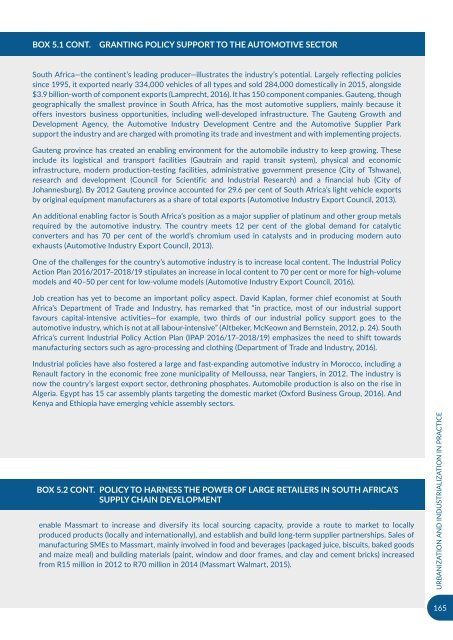URBANIZATION AND INDUSTRIALIZATION
Economic%20Report%20on%20Africa%202017%20UNECA
Economic%20Report%20on%20Africa%202017%20UNECA
Create successful ePaper yourself
Turn your PDF publications into a flip-book with our unique Google optimized e-Paper software.
BOX 5.1 CONT.<br />
GRANTING POLICY SUPPORT TO THE AUTOMOTIVE SECTOR<br />
South Africa—the continent’s leading producer—illustrates the industry’s potential. Largely reflecting policies<br />
since 1995, it exported nearly 334,000 vehicles of all types and sold 284,000 domestically in 2015, alongside<br />
$3.9 billion-worth of component exports (Lamprecht, 2016). It has 150 component companies. Gauteng, though<br />
geographically the smallest province in South Africa, has the most automotive suppliers, mainly because it<br />
offers investors business opportunities, including well-developed infrastructure. The Gauteng Growth and<br />
Development Agency, the Automotive Industry Development Centre and the Automotive Supplier Park<br />
support the industry and are charged with promoting its trade and investment and with implementing projects.<br />
Gauteng province has created an enabling environment for the automobile industry to keep growing. These<br />
include its logistical and transport facilities (Gautrain and rapid transit system), physical and economic<br />
infrastructure, modern production-testing facilities, administrative government presence (City of Tshwane),<br />
research and development (Council for Scientific and Industrial Research) and a financial hub (City of<br />
Johannesburg). By 2012 Gauteng province accounted for 29.6 per cent of South Africa’s light vehicle exports<br />
by original equipment manufacturers as a share of total exports (Automotive Industry Export Council, 2013).<br />
An additional enabling factor is South Africa’s position as a major supplier of platinum and other group metals<br />
required by the automotive industry. The country meets 12 per cent of the global demand for catalytic<br />
converters and has 70 per cent of the world’s chromium used in catalysts and in producing modern auto<br />
exhausts (Automotive Industry Export Council, 2013).<br />
One of the challenges for the country’s automotive industry is to increase local content. The Industrial Policy<br />
Action Plan 2016/2017–2018/19 stipulates an increase in local content to 70 per cent or more for high-volume<br />
models and 40–50 per cent for low-volume models (Automotive Industry Export Council, 2016).<br />
Job creation has yet to become an important policy aspect. David Kaplan, former chief economist at South<br />
Africa’s Department of Trade and Industry, has remarked that “in practice, most of our industrial support<br />
favours capital-intensive activities—for example, two thirds of our industrial policy support goes to the<br />
automotive industry, which is not at all labour-intensive” (Altbeker, McKeown and Bernstein, 2012, p. 24). South<br />
Africa’s current Industrial Policy Action Plan (IPAP 2016/17–2018/19) emphasizes the need to shift towards<br />
manufacturing sectors such as agro-processing and clothing (Department of Trade and Industry, 2016).<br />
Industrial policies have also fostered a large and fast-expanding automotive industry in Morocco, including a<br />
Renault factory in the economic free zone municipality of Melloussa, near Tangiers, in 2012. The industry is<br />
now the country’s largest export sector, dethroning phosphates. Automobile production is also on the rise in<br />
Algeria. Egypt has 15 car assembly plants targeting the domestic market (Oxford Business Group, 2016). And<br />
Kenya and Ethiopia have emerging vehicle assembly sectors.<br />
BOX 5.2 CONT. POLICY TO HARNESS THE POWER OF LARGE RETAILERS IN SOUTH AFRICA’S<br />
SUPPLY CHAIN DEVELOPMENT<br />
enable Massmart to increase and diversify its local sourcing capacity, provide a route to market to locally<br />
produced products (locally and internationally), and establish and build long-term supplier partnerships. Sales of<br />
manufacturing SMEs to Massmart, mainly involved in food and beverages (packaged juice, biscuits, baked goods<br />
and maize meal) and building materials (paint, window and door frames, and clay and cement bricks) increased<br />
from R15 million in 2012 to R70 million in 2014 (Massmart Walmart, 2015).<br />
<strong>URBANIZATION</strong> <strong>AND</strong> <strong>INDUSTRIALIZATION</strong> IN PRACTICE<br />
165


